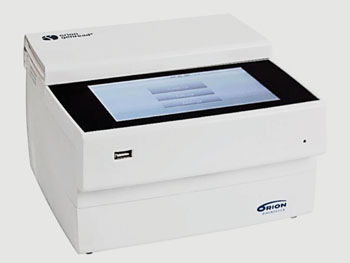Rapid Molecular Diagnostic Test Detects Zika Virus
By LabMedica International staff writers
Posted on 14 Sep 2016
Zika virus has only recently gained attention due to recent large outbreaks worldwide and an easy to use nucleic acid amplification test (NAAT) could play an important role in the early detection of the infection and patient management.Posted on 14 Sep 2016
Diagnosis of Zika virus has so far relied on serological methods, which are often time consuming or nucleic acid amplification tests (NAATs) such as real-time reverse transcription polymerase chain reaction (RT-PCR). RT-PCR requires the use of high precision instruments for thermal cycling reactions and skilled personnel for performing the complex protocol and data interpretation.

Image: The GenRead isothermal nucleic acid amplification device (Photo courtesy of Orion Diagnostica).
Scientists at Orion Diagnostica OY (Espoo, Finland) and a British colleague have developed an alternative NAAT, the reverse transcription strand invasion based amplification (RT-SIBA) assay for the rapid detection of Zika virus. During RT-SIBA reactions, Zika virus ribonucleic acid (RNA) is first reverse transcribed to complementary DNA (cDNA) followed by amplification and detection of cDNA under isothermal reaction conditions. SIBA relies on a recombinase-coated single-stranded invasion oligonucleotide (IO) for the separation of a complementary target duplex. They also compared the performance of RT-SIBA with real-time PCR for the detection of Zika virus. RT-SIBA reaction was performed using the real-time PCR device, Agilent MX3005P (Agilent Technologies, Santa Clara, CA, USA) and parallel reactions performed using a portable fluorescence detection device, Orion GenRead, that is suitable for point-of-care or field applications.
The team found that in RT-SIBA, the time to positive results for 1,000 copies of in vitro transcript RNA template was obtained after an average 17 minutes. Conversely, positive results for 1,000 copies of in vitro transcript RNA template by RT-PCR were obtained after an average 68 minutes. RT-SIBA allows for the simultaneous reverse transcription of Zika virus RNA and amplification of cDNA at the same reaction temperature. This allows for the rapid detection of Zika virus RNA within 30 minutes and was significantly faster than the RT-PCR method. Yellow fever, dengue 1, West Nile, chikungunya virus or any of the 15 different unrelated microorganisms were not detected by the RT-SIBA and RT-PCR Zika assays. This may indicate that both the RT-SIBA and RT-PCR assays are specific for the detection of Zika virus RNA.
The authors concluded that the rapid detection and high analytical sensitivity displayed by RT-SIBA for the detection of Zika virus, as well as tolerance to sample-derived inhibition, demonstrate that the method may be a powerful molecular diagnostic tool for the detection of Zika virus. Since the method can be run on portable and relatively low-cost devices, it may be applied in the rapid response to outbreaks. The study was published on September 1, 2016, in the journal Diagnostic Microbiology and Infectious Disease.
Related Links:
Orion Diagnostica














